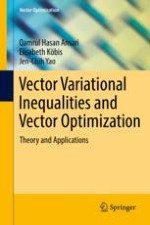This book presents the mathematical theory of vector variational inequalities and their relations with vector optimization problems. It is the first-ever book to introduce well-posedness and sensitivity analysis for vector equilibrium problems. The first chapter provides basic notations and results from the areas of convex analysis, functional analysis, set-valued analysis and fixed-point theory for set-valued maps, as well as a brief introduction to variational inequalities and equilibrium problems. Chapter 2 presents an overview of analysis over cones, including continuity and convexity of vector-valued functions. The book then shifts its focus to solution concepts and classical methods in vector optimization. It describes the formulation of vector variational inequalities and their applications to vector optimization, followed by separate chapters on linear scalarization, nonsmooth and generalized vector variational inequalities. Lastly, the book introduces readers to vector equilibrium problems and generalized vector equilibrium problems. Written in an illustrative and reader-friendly way, the book offers a valuable resource for all researchers whose work involves optimization and vector optimization.
